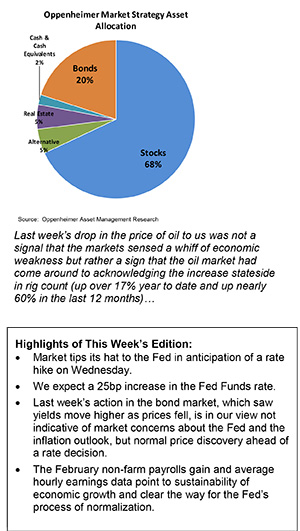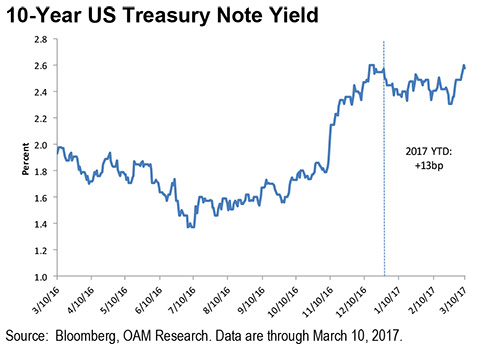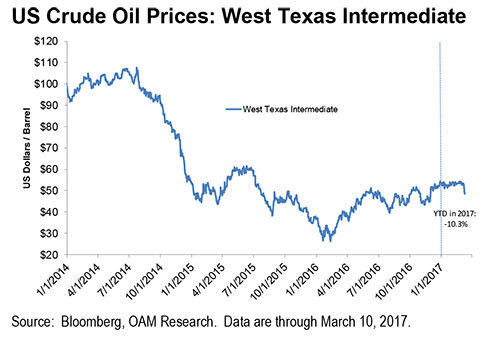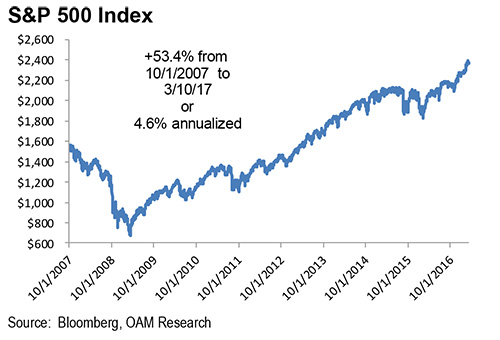Everyday, Everyday I Have the Blues
By John Stoltzfus,
Chief Investment Strategist
Doing What Comes Naturally
As the Federal Reserve positions itself to move ahead with its plans to normalize interest rates, markets (naturally) pause to reflect, rotate and fluctuate
No matter how well telegraphed the Fed’s intentions may be about the process of interest rate normalization, or how unsurprising a decline in the price of oil should be based on what’s been going on in the oil patch stateside, there’s always room for drama in the markets. In our experience the key is not to get too caught up in the day-to-day drama or distracted by the noise but rather to stay focused and keep the eye on the ball.
With February’s non-farm payroll number (surprising to the upside at 235,000 jobs added versus survey expectations for a gain of 200,000) and other key economic data released last week (including the unemployment rate and average hourly wages) already pretty much digested and in the markets’ rear-view mirror, investors are likely to stay focused with no small degree of concentration on this Wednesday afternoon at 2:00pm, when the Federal Reserve Board, having concluded its FOMC meeting, announces its much anticipated Fed Funds rate decision.

Based on futures expectations, widely publicized surveys of economists, investors’ and pundits’ commentaries, the announcement on Wednesday is likely to be near anti-climactic with an increase likely of 0.25% in the benchmark rate─unless the Fed should refrain from raising its benchmark rate at all or shocks the market with a larger than expected rate increase.
From our perch on the radar screen we’d anticipate no disappointment or shock by the market when the Fed announces its interest rate decision this week.
Last week’s action in the bond market, which saw the 10-year Treasury note’s yield move up to 2.6% (see figure below) along with a drop of just over 9% drop in the price of oil (WTI), sent conflicting signals that were interpreted as worrisome by some observers of last week’s action. “Was the 10-year Treasury’s move signaling that the Fed had fallen behind the curve in judging what might lie ahead in terms of higher inflation for the economy? Or was the drop in the price of oil signaling expectations for a drop in economic growth and hence demand for black gold?”

In our view, taken in context of transitions taking place stateside and around the world, the increase last week in the yield of the 10-year Treasury back to around 2.6% (near its peak of last year) was likely just a typical move ahead of a Fed decision during a rate hike/normalization cycle. We’d say it was more than likely bond price discovery in anticipation of a Fed increase rather than a warning signal about the rate of inflation or the Federal Reserve’s stance on it.
Last week’s drop in the price of oil, on the other hand, to us was not a signal that the markets sensed a whiff of economic weakness crossing the landscape but rather a sign that the oil market had come around to acknowledging the increase stateside in rig count (up over 17% year to date and up nearly 60% in the last 12 months), with stateside production beginning to edge higher, up over 3.6% year to date at the same time OPEC and its allies are limiting production and intent on keeping the price of oil stable to higher.

Weakness in the equity markets last week was not pronounced, in our opinion, but modest ahead of the Fed’s FOMC meeting and forthcoming statement. The S&P 500, the S&P 400 (mid-caps) and the Russell 2000 (small-caps) respectively declined 0.4%, 1.6% and 2.2% last week.
However, considering that those aforementioned indexes had respectively advanced some 19.3%, 23.5% and 27.3% in the last 12 months ended Friday, perhaps some profit taking, rotation and rebalancing were taking place as well as the market taking a breather to tip its hat to the Federal Reserve.

Not such a raging bull market. Taken in context of the S&P 500’s last cycle peak of 1565.15 on October 9, 2007, the S&P is up just under 52% since then, or around 4.5% annualized.
For the complete report, please contact your Oppenheimer Financial Advisor.
Other Disclosures
This report is issued and approved by Oppenheimer & Co. Inc., a member of all Principal Exchanges, and SIPC. This report is distributed by Oppenheimer & Co. Inc., for informational purposes only, to its institutional and retail investor clients. This report does not constitute an offer or solicitation to buy or sell any securities discussed herein in any jurisdiction where such offer or solicitation would be prohibited. The securities mentioned in this report may not be suitable for all types of investors. This report does not take into account the investment objectives, financial situation or specific needs of any particular client of Oppenheimer & Co. Inc. Recipients should consider this report as only a single factor in making an investment decision and should not rely solely on investment recommendations contained herein, if any, as a substitution for the exercise of independent judgment of the merits and risks of investments. The strategist writing this report is not a person or company with actual, implied or apparent authority to act on behalf of any issuer mentioned in the report. Before making an investment decision with respect to any security discussed in this report, the recipient should consider whether such investment is appropriate given the recipient's particular investment needs, objectives and financial circumstances. We recommend that investors independently evaluate particular investments and strategies, and encourage investors to seek the advice of a financial advisor. Oppenheimer & Co. Inc. will not treat non-client recipients as its clients solely by virtue of their receiving this report. Past performance is not a guarantee of future results, and no representation or warranty, express or implied, is made regarding future performance of any security mentioned in this report. The price of the securities mentioned in this report and the income they produce may fluctuate and/or be adversely affected by exchange rates, and investors may realize losses on investments in such securities, including the loss of investment principal.
Oppenheimer & Co. Inc. accepts no liability for any loss arising from the use of information contained in this report. All information, opinions and statistical data contained in this report were obtained or derived from public sources believed to be reliable, but Oppenheimer & Co. Inc. does not represent that any such information, opinion or statistical data is accurate or complete and they should not be relied upon as such. All estimates and opinions expressed herein constitute judgments as of the date of this report and are subject to change without notice. Nothing in this report constitutes legal, accounting or tax advice. Since the levels and bases of taxation can change, any reference in this report to the impact of taxation
INVESTMENT STRATEGY
should not be construed as offering tax advice on the tax consequences of investments. As with any investment having potential tax implications, clients should consult with their own independent tax adviser.
This report may provide addresses of, or contain hyperlinks to, Internet web sites. Oppenheimer & Co. Inc. has not reviewed the linked Internet web site of any third party and takes no responsibility for the contents thereof. Each such address or hyperlink is provided solely for the recipient's convenience and information, and the content of linked third party web sites is not in any way incorporated into this document. Recipients who choose to access such third-party web sites or follow such hyperlinks do so at their own risk. The S&P 500 Index is an unmanaged value-weighted index of 500 common stocks that is generally considered representative of the U.S. stock market. The S&P 500 index figures do not reflect any fees, expenses or taxes. This research is distributed in the UK and elsewhere throughout Europe, as third party research by Oppenheimer Europe Ltd, which is authorized and regulated by the Financial Conduct Authority (FCA). This research is for information purposes only and is not to be construed as a solicitation or an offer to purchase or sell investments or related financial instruments. This report is for distribution only to persons who are eligible counterparties or professional clients and is exempt from the general restrictions in section 21 of the Financial Services and Markets Act 2000 on the communication of invitations or inducements to engage in investment activity on the grounds that it is being distributed in the UK only to persons of a kind described in Article 19(5) (Investment Professionals) and 49(2) High Net Worth companies, unincorporated associations etc.) of the Financial Services and Markets Act 2000 (Financial Promotion) Order 2005 (as amended). It is not intended to be distributed or passed on, directly or indirectly, to any other class of persons. In particular, this material is not for distribution to, and should not be relied upon by, retail clients, as defined under the rules of the FCA. Neither the FCA’s protection rules nor compensation scheme may be applied. This report or any portion hereof may not be reprinted, sold, or redistributed without the written consent of Oppenheimer & Co. Inc. Copyright © Oppenheimer & Co. Inc. 2015.